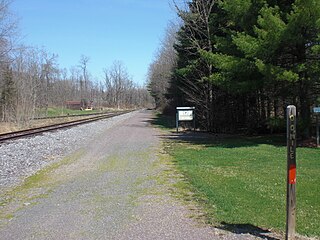| Overview | |
|---|---|
| Headquarters | Owego, New York |
| Reporting mark | LS, LSX |
| Locale | Luzerne County, Pennsylvania |
| Dates of operation | 1994– |
| Technical | |
| Track gauge | 4 ft 8+1⁄2 in (1,435 mm) standard gauge |
The Luzerne and Susquehanna Railway is a shortline railroad in Luzerne County, Pennsylvania. It both serves local traffic and connects to the Reading Blue Mountain and Northern Railroad in Pittston and to the Norfolk Southern Railway at three separate junctions. It operates a total of 55 miles of track in and around the Wyoming Valley in Luzerne County.
When formed in 1994 the railway incorporated tracks from a variety of defunct railroads, including the Pocono Northeast Railroad, Lehigh Valley Railroad, and Delaware, Lackawanna & Western Railroad. Major commodities hauled by the Luzerne and Susquehanna include chemicals, packaging, building products, and food & beverage. The total number of cars transported in 2010 numbered nearly 4000.
The Luzerne and Susquehanna Railway is headquartered at 25 Delphine Street in Owego, New York, as part of a holding company for three shortline railroads in the Twin Tiers along with a disjunct shortline railroad in Mississippi. The line's tracks are owned by the Luzerne County Redevelopment Authority.
The railroad was purchased by R.J. Corman Railroad Group on August 19, 2020.

Wilkes-Barre is a city in the U.S. state of Pennsylvania and the county seat of Luzerne County. Located at the center of the Wyoming Valley in Northeastern Pennsylvania, it had a population of 44,328 in the 2020 census. It is the second-largest city, after Scranton, in the Scranton–Wilkes-Barre–Hazleton, PA Metropolitan Statistical Area, which had a population of 563,631 as of the 2010 census and is the fourth-largest metropolitan area in Pennsylvania after the Delaware Valley, Greater Pittsburgh, and the Lehigh Valley with an urban population of 401,884.

Luzerne County is a county in the U.S. state of Pennsylvania. According to the U.S. Census Bureau, the county has a total area of 906 square miles (2,350 km2), of which 890 square miles (2,300 km2) is land and 16 square miles (41 km2) is water. It is Northeastern Pennsylvania's second-largest county by total area. As of the 2020 census, the population was 325,594, making it the most populous county in the northeastern part of the state. The county seat and largest city is Wilkes-Barre. Other populous communities include Hazleton, Kingston, Nanticoke, and Pittston. Luzerne County is included in the Scranton–Wilkes-Barre–Hazleton Metropolitan Statistical Area, which has a total population of 555,426 as of 2017.

Pittston Township is a township in Luzerne County, Pennsylvania. The population was 3,179 as of the 2020 census. The township is located within the Greater Pittston region. As of 2010, the total population of Greater Pittston was 48,020. The Wilkes-Barre/Scranton International Airport is located in Pittston Township.

The Delaware, Lackawanna and Western Railroad was a U.S. Class 1 railroad that connected Buffalo, New York, and Hoboken, New Jersey, a distance of 395 miles (636 km). Incorporated in Pennsylvania in 1853 primarily for the purpose of providing a connection between the anthracite coal fields of Pennsylvania's Coal Region and the large markets for coal in New York City. The railroad gradually expanded both East and West, eventually linking Buffalo with New York City.
Suscon is an unincorporated community in Pittston Township, Luzerne County, Pennsylvania, United States, northeast of Wilkes-Barre and south of Scranton. It is named for its position at the former junction of the Susquehanna Connecting Railroad and the Wilkes-Barre and Eastern Railroad. It uses the Pittston zip code of 18640.

The Massena Terminal Railroad is a Class III terminal railroad operating in the U.S. state of New York. It operates over 4 miles (6.4 km) of track from the CSX Transportation yard in Massena north to the Alcoa plant, the railroad's only customer. It was built in the early 20th century, beginning operations in 1900. In 2005, the railroad was purchased by holding company RailAmerica. Shortline holding company Genesee & Wyoming acquired the Massena Terminal Railroad in 2012 as part of its purchase of RailAmerica. The railroad's traffic comes mainly from aluminum and petroleum products. The MTR hauled around 4,300 carloads in 2008. As of 2019, the company operates 4 miles (6.4 km) of tracks.
The Chattahoochee Valley Railway was a shortline railroad linking a number of textile mills between West Point, Georgia and McGinty, Alabama for a total distance of 9.5 miles (15.3 km). As a subsidiary of West Point Pepperell, the entire railroad was abandoned in 1992.

The North Shore Railroad is a short line railroad that operates 44 miles (71 km) of track in Northumberland, Montour, Columbia, and Luzerne counties in Pennsylvania in the United States. The line runs generally northeast between Northumberland and the unincorporated village of Beach Haven in Salem Township.

The Nittany and Bald Eagle Railroad is a short line railroad that operates 73 miles (117 km) of track in Blair, Centre, and Clinton counties in Pennsylvania in the United States. It is part of the North Shore Railroad System.

Greater Pittston is a 65.35 sq mi (169.25 km²) region in Luzerne County, Pennsylvania, in reference to the area in and around Pittston. As of 2010, the total population of Greater Pittston is 48,020. This region includes Avoca, Dupont, Duryea, Exeter Boro, Exeter Township, Hughestown, Jenkins Township, Laflin, Pittston Township, West Pittston, West Wyoming, Wyoming, and Yatesville.

Lehigh Gorge State Park is a 4,548 acres (1,841 ha) Pennsylvania state park in Luzerne and Carbon Counties, Pennsylvania. The park encompasses a gorge, which stretches along the Lehigh River from a U.S. Army Corps of Engineers flood control dam in Luzerne County to Jim Thorpe in Carbon County. The primary recreational activity at Lehigh Gorge State Park is white water rafting.

The Central New York Railroad is a shortline railroad operating local freight service along ex-Southern Tier Line trackage in the U.S. states of New York and Pennsylvania. The line begins at Port Jervis, following the Delaware River to Deposit and the Susquehanna River from Lanesboro, where it passes over the Starrucca Viaduct, to Binghamton. It is a subsidiary of the Delaware Otsego Corporation, which also owns the New York, Susquehanna and Western Railway, operator of through trains over the line.

The Lackawanna and Bloomsburg Railroad (LBR) was an 80-mile (129 km) long 19th century railroad that ran between Scranton and Northumberland in Pennsylvania in the United States. Incorporated in 1852, the railroad began operation in 1856 and was taken over by the Delaware, Lackawanna and Western Railroad in 1873. The western end of the line, from Northumberland to Beach Haven, is still in operation as the shortline North Shore Railroad.

R. J. Corman Railroad Group, LLC is a privately owned railroad services and short line operating company headquartered in Nicholasville, Kentucky, with field locations in 22 states. It was owned by Richard J. Corman, who established the company in 1973, and ran it until his death on August 23, 2013. The company owns seventeen short-line railroads spanning Indiana, Kentucky, Mississippi, North Carolina, Ohio, Pennsylvania, South Carolina, Tennessee, Texas, and West Virginia.

The Laurinburg and Southern Railroad is a short-line railroad operating in North Carolina. The railroad has 28 mi (45 km) of track that runs south from Raeford to Laurinburg, North Carolina and industries south of there. However much of the track is seldom run on and used for car storage. In the past the Laurinburg and Southern controlled a number of other small railroads in North Carolina and Virginia. The railroad has been owned by Gulf and Ohio Railways since 1994.
The Lehigh Railway is a shortline railroad in Wyoming County and Bradford County, Pennsylvania. It connects to the Reading Blue Mountain and Northern Railroad in Mehoopany and to Norfolk Southern in Athens, just south of Sayre. It operates a total of 56 miles of track along the Susquehanna River. Since 2020, the railroad has been operated by the R.J. Corman Railroad Group as its Lehigh Line.

Ashley Planes was a historic freight cable railroad situated along three separately powered inclined plane sections located between Ashley, Pennsylvania at the foot, and via the Solomon cutting the yard in Mountain Top over 1,000 feet (300 m) above and initially built between 1837-38 by Lehigh Coal & Navigation Company's subsidiary Lehigh and Susquehanna Railroad (L&S). One result of the 1837 updates of omnibus transportation bills called the Main Line of Public Works (1824), the legislation was undertaken with an eye to enhance and better connect eastern settlement's business interests with newer mid-western territories rapidly undergoing population explosions in the Pre-Civil War era. But those manufactories needed a source of heat, and the Northern Pennsylvania Coal Region was barely connected to eastern markets except by pack mule, or only through long and arduous routes down the Susquehanna then overland to Philadelphia.

The Susquehanna Warrior Trail is a 12.21-mile (19.65 km) rail trail for bicyclists and pedestrians that runs along the west bank of the Susquehanna River in Luzerne County, Pennsylvania. The trail was created in 2005, and opened to the public in 2007. The Susquehanna Warrior Trail has not yet been dedicated. The trail is part of a plan to create a trail network covering all of Luzerne County.

The Nesquehoning Valley Railroad Company, herein called the Nesquehoning Valley Railroad (NVRR), is now a fallen flag standard-gauge, steam era shortline railroad built as a coal road to ship the Anthracite mined in the Southeastern Coal Region on either side of the Little Schuylkill River tributary Panther Creek and the history making coal towns of the Panther Creek Valley down the Lehigh River transportation corridor to the Eastern seaboard.

The Lehigh Line is a railroad line in central New Jersey, Northeastern Pennsylvania, and the Lehigh Valley region of eastern Pennsylvania. It is owned and operated by the Norfolk Southern Railway. The line runs west from the vicinity of the Port of New York and New Jersey via Conrail's Lehigh Line to the Susquehanna River valley at the south end of the Wyoming Valley Coal Region. Administratively, it is part of Norfolk Southern's Keystone Division and is part of the Crescent Corridor. As of 2021 the line is freight-only, although there are perennial proposals to restore passenger service over all or part of the line.